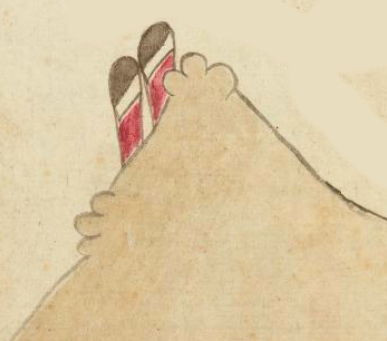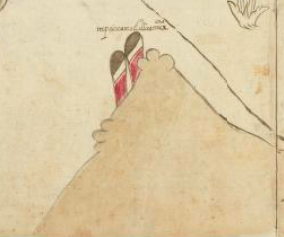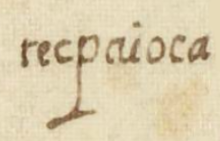Tecpayocan (Azca15)
This painted black-line drawing of the compound glyph for the place name Tecpayocan ("Place with the Aspect of a Knife," or "...Knives") shows a hill or mountain (probably a tepetl) with two flint knives (tecpatl) appearing from just behind, at the top-left of the mountain. The mountain has curling rocky (tetl) outcroppings at the top and midway down on the left slope. The stones are a semantic indicator that mountains are rocky and/or phonetic indicator that the term for mountain starts with te-. The knives are (unusually) rounded at the top, instead of pointed. They are red (at the bottom), black (at the top) and white, the latter color used for the diagonal stripes that cut through the knives. Red often appears at the lower point of flint knives, perhaps suggesting the blood that might be drawn when the knives pierce human or animal flesh.
Stephanie Wood
tecpaioca
Tecpayocan
Stephanie Wood
post-1550, possibly from the early seventeenth century.
Jeff Haskett-Wood
cuchillos, pedernales, montañas, cerros, pueblos, nombres de lugares, topónimos

tecpa(tl), flint knife, https://nahuatl.wired-humanities.org/content/tecpatl
-yocan, place where there is a lot of (the preceding noun), https://nahuatl.wired-humanities.org/content/yocan
-yo(tl), having that nature, https://nahuatl.wired-humanities.org/content/yotl
-can (locative suffix), https://nahuatl.wired-humanities.org/content/can-2
Lugar Que Tiene el Aspecto del Pedernal
Stephanie Wood
The Codex Azcatitlan is also known as the Histoire mexicaine, [Manuscrit] Mexicain 59–64. It is housed in the Bibliothèque Nationale de France, and hosted on line by the World Digital Library and the Library of Congress, which is “unaware of any copyright or other restrictions in the World Digital Library Collection.”
https://www.loc.gov/resource/gdcwdl.wdl_15280/?sp=15&st=image
The Library of Congress is “unaware of any copyright or other restrictions in the World Digital Library Collection.” But please cite Bibliothèque Nationale de France and this Visual Lexicon of Aztec Hieroglyphs.



